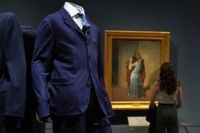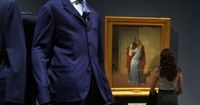The city of Milan, famed for its fashion and art, is currently hosting an extraordinary tribute to one of its most beloved icons. On September 24, 2025, the Pinacoteca di Brera—a gallery renowned for its collection of Italian masterworks—opened its doors to "Giorgio Armani: Milano, Per Amore," an exhibition that intertwines the legendary designer’s creations with the artistic heritage of Italy. The event, which will run until January 11, 2026, marks not only the 50th anniversary of Armani’s signature label but also serves as a poignant homage following his passing on September 4, 2025, at the age of 91.
This highly anticipated exhibition was crafted with Armani’s own involvement in its final months, a testament to his meticulous vision and enduring connection to the Brera neighborhood. According to V Magazine, more than 120 of Armani’s garments—spanning from the 1980s to the present day—are displayed in dialogue with masterpieces by Caravaggio, Tintoretto, Giovanni Bellini, Raphael, Mantegna, Piero della Francesca, Donato Bramante, and Francesco Hayez. Each ensemble was carefully chosen to reflect and converse with the mood of its surrounding artworks, creating what Associated Press described as a "symbiosis" between fashion and fine art.
Angelo Crespi, director of the Pinacoteca di Brera, emphasized the unique nature of this collaboration. "Giorgio Armani represents one of the highest pinnacles of Italian creativity, expressed in the essentiality and rigour of form, a rigour that evolved from aesthetic to in the sense that it permeated his way of living and working," Crespi stated in a release quoted by V Magazine. He added, "In this, Giorgio Armani embodies the character of Milan most fully. He is also the most emblematic expression of the culture of Brera, a unique place in the world where art, research and innovation have been practised for five hundred years."
Yet, the exhibition’s concept was not an immediate sell for Armani. As AP reported, the designer initially hesitated at the idea of placing his creations alongside such revered masterpieces. But after a private tour of the gallery, he began to envision how his garments could enhance, rather than compete with, the museum’s treasures. "He always said that he did not want to enter into close dialogue with great masterpieces, like Raphael, Mantegna, Caravaggio and Piero della Francesca," Crespi explained to AP. Instead, the exhibition was designed to let Armani’s looks echo the atmosphere of each room, blending seamlessly into the museum’s narrative—much the way Armani intended his clothes to complement, not overshadow, the individual wearer.
Chiara Rostagno, Deputy Director of the Pinacoteca di Brera, described the show as "a dialogue between Giorgio Armani, the museum and its artistic heritage, conveyed through a selection of his creations." She noted that Armani was particularly moved by Mantegna’s "Lamentation over the Dead Christ," a painting renowned for its raw realism. Out of respect, Armani requested that his garments not be placed in direct view of this masterpiece, a detail that speaks to the humility and reverence he brought to the project.
Among the 129 looks on display, visitors will find a midnight blue velvet dress with quasi-ecclesiastical embroidery, its Maltese crosses harmonizing with the frescoed chapel backdrop. A long blue asymmetrical skirt and bodysuit ensemble worn by Juliette Binoche at the 2016 Cannes Film Festival is positioned to reflect the blue hues of Bellini’s "Madonna and Child" from 1510. A trio of underlit dresses glows opposite Raphael’s "The Marriage of the Virgin," their draping and geometry subtly echoing the Renaissance master’s style. Perhaps most famously, the exhibition features the soft-shouldered suit worn by Richard Gere in "American Gigolo"—the very garment that catapulted Armani to international fame—displayed among the architectural frescoes of Donato Bramante.
Every detail of the exhibition underscores the timelessness of Armani’s design. The seamless juxtaposition of his 1980s looks with contemporary pieces demonstrates a consistency of vision that has defined the brand for half a century. In the final room, Armani himself makes a subtle appearance on a T-shirt, placed opposite Francesco Hayez’s iconic painting "Il Bacio" ("The Kiss"), a gesture that feels both intimate and fitting.
For those who knew Armani, the exhibition is deeply personal. Anoushka Borghesi, Armani’s global communications director, told AP, "When I walk around, I think he would be super proud." The Brera location is especially significant, as it abuts Armani’s longtime home, offices, and showroom. The Academy of Fine Arts, part of the Brera complex, even granted Armani an honorary title in 1993—a nod to his longstanding relationship with the institution.
The exhibition is just one component of a series of events marking Armani’s 50th anniversary, all meticulously planned by the designer himself before his death. Among the most notable is the announcement of "Mariu’," a philanthropic initiative named after Armani’s mother. In partnership with the Catholic charity Caritas, the project will support education for children in six countries across Southeast Asia, Africa, and South America. This charitable effort, according to AP and V Magazine, reflects Armani’s enduring commitment to social responsibility and the values instilled in him from childhood.
In a final, emotional tribute, Armani’s last collection—personally curated by the designer—will be presented at the Brera Gallery on Sunday, September 28, 2025. This show, set amidst the very masterpieces that inspired him, promises to be a fitting farewell to a man whose influence on global fashion is immeasurable.
For visitors and locals alike, "Giorgio Armani: Milano, Per Amore" offers more than a retrospective of elegant garments; it’s an immersive journey through the evolution of taste, culture, and artistry in Milan. The exhibition’s thoughtful curation, its interplay with Italy’s artistic giants, and its celebration of Armani’s legacy all combine to make it a must-see event—one that honors not just a designer, but a visionary who shaped the very soul of his city.
The exhibition will remain open to the public until January 11, 2026, inviting all who enter the Pinacoteca di Brera to experience the enduring dialogue between fashion and art, and to remember the man who brought them together so gracefully.






